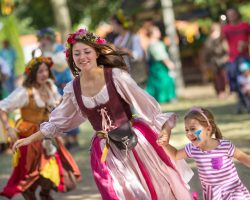
Steve Wannall’s Survival Guide to Being a Renaissance Festival Performer
Why Perform at a Renaissance Festival?
Over the past couple of decades, the phenomenon that is the renaissance festival has been rapidly growing in popularity. From single weekend tent events, to giant villages filled with permanent structures, “renfaires” seem to be popping up all over. Still, this form of entertainment maintains a very unique quality…and it requires an equally unique type of entertainer. More and more actors, magicians, jugglers, mimes, and special entertainment performers of all kinds find themselves drawn to the nearest festival to find work. If you fit into this category (or even if you want to try to break into the business), then read on! You’ve come to the right place!
Stage vs. Street: What Kind of Performer to Be
The first thing to understand about performing for a renfaire, is that there are several ways to do it. The most common is to become a “strolling character.” Strolling characters are usually a collection of simple villagers or high class royalty who roam the festival at will and interact with the patrons in character. Sometimes these characters will represent actual historic figures like Henry VIII, or Queen Elizabeth, but often they are fictional period characters who are there to provide the appropriate atmosphere.
Strolling characters are typically hired through a normal audition process, and they become the workhorses of any given renfaire. They typically work the hardest of any of the performers, and usually get paid the least (depending on the character or amount of responsibility). Despite this fact, many performers find the job very rewarding. Aside from the physical demand, a strolling character is always “on.” In other words, they must remain in character for the entire time they are on the job. Because of this, they usually undergo a very specific rehearsal process, in which they must learn to speak with the appropriate accent and period language, as well as becoming versed in period mannerisms and greetings.
A strolling character must be prepared to know everything of historical significance pertaining to their character. A village worker must know what kinds of tools might be at their disposal, as well as period terms associated with their job. The village mayor, or sheriff must know a thing or two about renaissance politics. Of course, anyone portraying an actual historic figure must know everything about their character inside and out. Being so immersed in a role can be a fun challenge for an actor, but it can also prove hard to “turn off” at the end of the day. Just remember the phrase: “the beer is in the pickup truck” when trying to get rid of an accent you have been using all day long (although, by using this method you run the risk of simply replacing one accent with another).
Depending on the festival, strolling characters will often need to learn scripted material created to build specific interactions between characters. Sometimes, there is a plot line that is followed throughout the course of a day which may involve making appearances at certain locations, or even being in a staged play.
Some festivals will cast other plays and street performers out of their already existing cast of “strollers.” This may provide opportunities for additional income, but it also might mean more of a physical demand. Needless to say, there is a lot to take into consideration before becoming a strolling character.
The second type of renfaire performer is the stage act. These are the headline entertainers with already existing, pre-rehearsed, and pre-packaged shows which they perform on stage, or in the street at regular intervals. Performers in this group include jugglers and magicians, sword-swallowers and acrobats, singers and dancers, and a myriad of other entertainers with special skills. Being a stage act can be a very different experience from being a strolling character, but it has its own set of pros and cons.
On the plus side, stage acts typically make a lot more money for a lot less work. Instead of being in character for a whole day of walking around, stage acts usually perform intermittently in fixed locations for only short periods of time (typically anywhere from 20-45 minutes). While some stage acts find themselves performing a large number of shows, occasionally at different locations, there is usually plenty of down time for breaks. Depending on the success of the show, stage acts may even enjoy a slight feeling of celebrity from developing a fan base. While a stage act at a renfaire does have to make some concessions for the period (it doesn’t make much sense for a magician to be doing tricks with lasers and buzz saws), they usually have a bit more leniency as far as what they can get away with. It is not at all unusual for a special events entertainer used to performing in bars and clubs to perform a slightly “tweaked” version of their normal “non-renaissance” show.
On the negative side…getting a job as a stage act at a festival means building and rehearsing a whole show entirely on your own…and then convincing an entertainment director or festival owner to buy it. This means putting together a good pitch and some promotional material, or at least some decent video footage of your act. The bad news here, is that it is a highly competitive market, with many different acts all vying for the same venues. In order to land a job at the best faires, a stage act either needs to be singularly unique, or VERY high quality. Building a show that fits with the theme very often means having a special skill or talent (such as juggling), although a good performer will find that just a little bit of creativity can go a long way.
Stage acts will also find that certain festivals are what we call “hat faires.” These are festivals where an act’s base pay will be lower (or even non-existent) because they are allowed to “pass the hat” during their performances. Busking for your pay may be appropriate to a renaissance setting, but it also means not having as steady of an income. There will be days when there are huge crowds who love you and are willing to throw all kinds of cash your way…and then there will be days when the crowds are small and strapped for cash after paying for their admission to the festival, souvenirs for the kids, and food for the whole family.
Stage acts are also responsible for supplying their own props and period costumes…which can get kind of expensive. In some cases, a stage act might manage to get the festival’s resident costumer to outfit them, but having something already put together to sell to a renfaire is always preferable.
An important skill for a stage act to have, is that of contract negotiation. Before accepting any renfaire job, it is a good idea to know any up-front expenses, and exactly how much money you will need in order to make the job worth it.
Be Prepared for the 16th Century!
Health and hygiene for outdoor performing
As a veteran renfaire performer, I have accumulated a good deal of experience acting in an outdoor setting. I have also witnessed the culture shock of many an entertainer performing in the rain or blinding sunlight for the first time. Needless to say, it takes a very different skill-set than acting in a darkened theater or nightclub. A lot of the following advice may seem obvious…but for anyone preparing to don the garb in the near future…this bears repeating.
1. Wear comfortable footwear.
Okay, I know it seems like there isn’t much choice in the matter. Period shoes are period shoes, and most of them aren’t made with comfort in mind. Still, if your feet are getting punished, your whole body will suffer. Luckily, this isn’t too hard to fix. There are many brands of new boots and shoes that are made in a renaissance-passable style, and if you are willing to spend some money, every faire has their own cobbler shops that make very high quality boots, moccasins, etc. specifically for use at festivals (I also recommend shopping online for the best deals). In a pinch, get yourself a good insert with arch support. You won’t regret it.
2. Cover your noggin!
16th century hats, hoods, and snoods are not only stylish and period appropriate, they can save you a lot of grief. True, some of them don’t do much more than look pretty (or even pretty stupid), but they can keep you dry in the rain, and shield your eyes from the sun. For a nifty trick…you can even conceal a small watch inside of a hat. That way, if you get asked for the time (and you will), you need only lift off your hat, use it to shield your eyes as you pretend to gaze in the direction of the sun, and then boldly pronounce the time of day.
3. Wear sunscreen.
Duh.
4. Stay cool and hydrate.
Again, duh. This one is especially important however, because at a renfaire this might not be all that easy to do. If you happen to be portraying royalty (thank the Lord that I never do), you are particularly susceptible to heatstroke, as you will probably be wearing enough upholstery to build a couch. The best thing to do is budget your time to include breaks where you can strip off layers. And for pity’s sake, stay away from the ale and drink water!
5. Carry anti-bacterial hand sanitizer.
Some festivals have full, amusement park quality bathrooms with running water. At others, you will get little more than plastic port-o-johns. In either case, you’re going to want an easy way to keep your hands clean before you start gnawing on that turkey leg or hunk-o-meat-on-a-stick. Even if your village is the kind with the nice washrooms (personally, I think the existence of “nice” ones is a myth), you may find yourself avoiding going to them for several reasons. Ladies can attest to how difficult it is to hit the privy wearing a hoop skirt and corset. And guys…take it from me…it’s no fun having to stand at a urinal next to someone who’s “a big fan!” On the same note as clean hands, I highly suggest keeping your nails trimmed. Many faires are pretty dusty, and grime can build up quick (just ask a performer at a festival without paved pathways what it’s like to blow their nose at the end of a day).
6. Know where first aid is.
Any festival that hires you will give you some kind of orientation on this subject. Take it seriously. Festivals are fun, but there are a dozen ways for a performer to get sick or injured.
7. Remember, you are not REALLY in the renaissance!
There is historical accuracy, and then there is just plain stupid. Many of the customs, fashions, and practices from centuries ago are no longer in existence for a good reason…because people DIED from them. There is nothing wrong with wearing a stylish little fox tail on your belt, which was done in the renaissance to attract plague-carrying fleas away from the body, but it is no excuse to stop bathing! And ladies, a tight corset may be attractive (and historically accurate), but use your better judgment when lacing them. There has actually been a rise of ailments that have not been seen among women for 300 years…specifically because of the new popularity of renfaires and all the corsets that women are once again wearing! When in doubt, go with your modern education over obsessively staying in character.
Best Festival Poll!
To anyone who has ever worked at, attended, or even just looked into more than one renaissance festival…here’s your chance to sound off!

